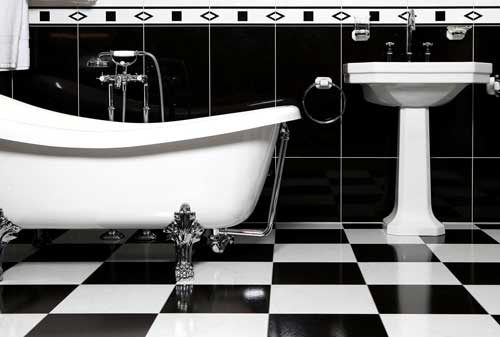The bathroom and kitchen are both wet areas that are heavily used every day, which means that their floors need to be durable and water resistant. The bathroom presents the biggest flooring challenge. It’s often small, and with showers and baths going on, it’s very likely that water is going to pool on the floor at least occasionally. On the other hand, wet feet mean a danger of slipping, so it’s also important that a bathroom floor be slip resistant. Here are six materials that are good for bathroom floors, balancing water resistance, slip resistance, durability and easy maintenance.

1. Ceramic Tile
Ceramic and porcelain tile is made of fired clay which is then glazed on one side, giving it a decorative finish and sealing it, making it waterproof. Because it’s a natural material that’s relatively inexpensive, quite water resistant and good looking, ceramic tile is probably the most popular material for bathroom floors. It’s available in a wide range of colours and designs. The disadvantages? Large, smooth tiles can be slippery, the mortar joints can be susceptible to staining and laying tile over a wood floor can block access to pipes. Additionally, since installed tile is less flexible than the wood floor structure that’s often underneath it, the tiles can crack and the mortar joints can loosen. Tile is perfect for installation over a concrete floor, however.
2. Vinyl
Vinyl is a waterproof artificial material, and a vinyl floor that’s cut in a single piece is very thoroughly water resistant. Vinyl tiles are less so. A third option is vinyl strip flooring, which is often fashioned to look like wood. Vinyl comes in all sorts of colours and designs. It’s easy to install and easy to keep clean. However, with the possible exception of vinyl strip flooring, it’s not nearly as durable as a good tile installation. Look for vinyl flooring with some texture to avoid slips.
3. Stone tile
Stone tile is a handsome choice for a bathroom floor. However, it tends to be more porous than ceramic tile and it needs to be kept sealed. That makes it higher maintenance. Other than that, it’s advantages and disadvantages are similar to ceramic tile’s.
4. Linoleum
Vinyl flooring is sometimes mistakenly called “lino” or “linoleum,” however, real linoleum is made from linseed oil, pine resin, and ground cork and wood, along with mineral ingredients. It can be manufactured in many different colours and designs. High quality linoleum is more flexible than tile and more durable than vinyl. It’s a natural material and a great choice for a bathroom floor. Look for linoleum with some texture, impregnated colour and sufficient thickness for good durability.
5. Cork
Cork is a natural material that’s soft, warm and naturally resistant to mould and mildew. It can make a very pleasant bathroom floor. However, it needs to be properly sealed and well maintained in order to stay in good condition, as it is highly porous.
6. Concrete
Concrete doesn’t sound like a very pretty or stylish flooring material, but these days, it can be. There are all kinds of new methods for polishing, colouring and finishing concrete, so if your bathroom already has a concrete floor, then consider giving it an attractive finish rather than tiling over it. Keep slip resistance in mind when choosing a finishing method.
Look for bathroom flooring materials in Fowles’ Home Renovator auction and Timber and Building Materials auction. Check our Carpet Auction, too; it often includes vinyl flooring. You’ll find bathroom floor materials for sale at our retail shop, as well.
